Planning for your active years in retirement can help ensure you enjoy recreational or leisurely pursuits without
jeopardizing your finances in your less active years.
Retirement can be an exciting time to look forward to. You may plan on travelling, spending time with family, indulging your hobbies, or just enjoying life at a more leisurely pace. By planning ahead, you can help ensure you have the financial resources to enjoy this relaxed lifestyle, worry-free.
Planning also means considering your later years of retirement, when you may slow down or need additional care.
Douglas Lamb, a CFP® professional, Elder Planning Counselor, and Financial Advisor with HollisWealth Advisory Services Inc. in Toronto, offers his tips for a smooth transition into the phases of retirement.
What are the Phases of Retirement?
Retirement can typically be broken into two phases, and each one requires careful planning.
Active Retirement
This is the phase, typically between ages 65 and 75, where health concerns don’t stop you from participating in physical activities. Now’s the time to get out the bucket list and follow your dreams while you’re at your most active.
Less Active Retirement
During the second phase of retirement, activity levels may be more moderate. You might choose to cut down on driving or stay closer to home when you go on vacation. Additional health-related expenses may become a bigger priority. The key during this time is to accept any limitations as graciously as you can. Enjoy life and focus on everything you can do, rather than what you can’t.
Plan Ahead
One of the biggest concerns during the active phase of retirement is whether you can actually afford to do all the activities on your bucket list without compromising your future financial situation.This is why having a long-term plan in place is so important. A detailed plan, established before you enter active retirement, will help give you the confidence to spend money on the things you enjoy—while you’re most able to enjoy them.
An acceptable plan is one where financial resourcesoutlive the individual, says Lamb. He adds that a financial plan should cover you through age 100.
When planning, start by envisioning your lifestyle through the various phases of retirement to end-of-life care. To help bring this vision to life, work with aCFP professional or QAFP® professional to map out current and future expenses.
This includes the following:
- Mortgage/rent
- Home maintenance
- Insurance
- Travel and food
- Potential medical expenses
- Assisted living costs
Work with your professional financial planner to develop a plan that works for your specific needs and recognize the uncertainty of thinking decades into the future. That may mean erring on the conservative side, says Lamb, both with your annual budget and your expected investment returns. Careful planning early on can be the difference between an enjoyable, stress-free retirement and one where money worries overshadow the leisure you deserve.
To find the right CFP professional or QAFP professional to guide your retirement planning, use our Find Your Planner tool.

 Find Your Financial Planner
Find Your Financial Planner

